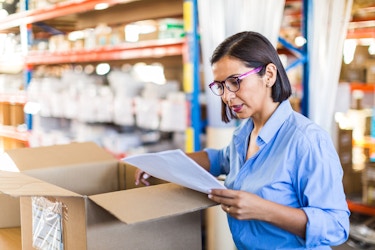
“Click-to-brick” describes the movement of online-first, e-commerce brands opening offline brick-and-mortar storefronts. Digital-first retailers like Glossier, Warby Parker, and Casper are among the many e-commerce brands opening physical locations as part of their growth strategies. Shopify estimates that retailers that take a multichannel approach will generate $575 billion by 2023.
Is opening a physical location the right next step for your online brand? Here are some questions that can help you think through this big decision.
Do you have the capital to invest in an offline location?
Opening a physical storefront is a significant investment. Quickbooks estimates that renting an office space costs anywhere from $8 to $23 per square foot, and that’s without factoring in expenses like utilities, insurance, and hiring retail associates. You’ll also need to budget for equipment like a POS system, displays, and inventory.
[Read more: How a New Wave of DTC Startups Are Tapping Big Retail to Scale Growth]
Many business owners take out a loan to support their first offline location. If you do this, make sure you overestimate how much you’ll need. “Costs that you did not plan for will certainly arise as you prepare the store for opening. Many of these oversights will be small, but some can be large, and they can all add up affecting your success in the long run,” wrote LiveAbout.
Your cash flow should also inform your decision to finance an offline location. You may want to ensure you have stable, predictable cash flow from your e-commerce site before you invest in building an offline presence. Cash flow is the reason why 82% of small businesses fail, according to SCORE.
Is there a demand for an offline storefront?
Many business owners test the waters with a pop-up location or event to see if there’s enough demand to warrant opening a permanent location. Hosting a pop-up can also help you determine if the location you’re considering gets the desired foot traffic, works for your employees, and is in the right place for your existing customer base.
“By testing your experience with a pop-up or limited-time event, you should be able to get the feedback to start finding real estate, design your in-store experience, and open new marketing channels,” wrote Clover. “Use your pop-up to see if your customer base is located in an area focused enough to sustain a physical store.”
For some brands, the tactile experience of trying on and touching your products could be enough to boost sales.
Hosting a limited-time event can also help you build momentum going into a grand opening. Get your customers excited for a permanent location by previewing what they can expect — and differentiating your offline and online experiences.
Does seeing your products in person benefit sales?
An offline store should add something new and enable you to create an omnichannel experience for your customers. Rather than simply replicating the process of shopping online, think about how your brick-and-mortar location can engage your customers in different ways.
“You are limited to the type of customer experiences you can create when your business is entirely online,” wrote GoDaddy. “A physical store allows you to create new, exciting, and interconnected experiences for your customers using omni-channel marketing.”
For some brands, the tactile experience of trying on and touching your products could be enough to boost sales. Research from CalTech found that some customers are willing to pay 50% more for a product they can touch. Other brands introduce tailored, bespoke customer service and community-building events.
Glossier is a great case study on how to boost sales while creating a branded in-store experience. The beauty company designed its retail locations to facilitate discovery and community, rather than focus on transactions. Nevertheless, Glossier’s retail locations (before the pandemic) had an average conversion rate of 50% and accounted for 20% of the brand’s sales.
[Read more: Considering Opening a Retail Store? The Pros and Cons of Brick-and-Mortar Locations]
Ultimately, whether you open a physical location depends on your budget, your customers, and the type of product you offer. Consider whether or not an offline location will add value to your brand, engage customers in unique ways, and help generate new sales. Often, it comes down to trying a few locations before signing a lease.
CO— aims to bring you inspiration from leading respected experts.
However, before making any business decision, you should consult a
professional who can advise you based on your individual situation.
CO—is committed to helping you start, run and grow your small business. Learn more about the benefits of small business membership in the U.S. Chamber of Commerce, here.
Next Event: Tax Filing Tips!
Join us on Thursday, February 22, at 12 pm ET for the first episode of our expert series, Ready. Set. Scale.: Smart Tax Tips for a Stress-Free Filing. We will have seasoned leaders offering actionable tips to help minimize the stressors of tax time for small businesses.








